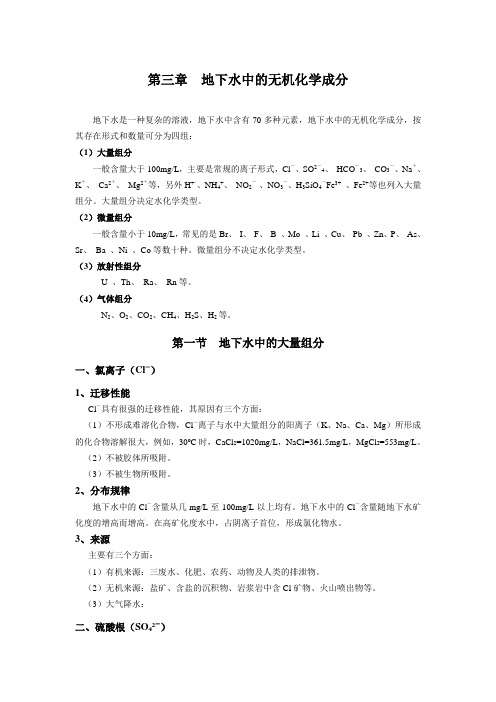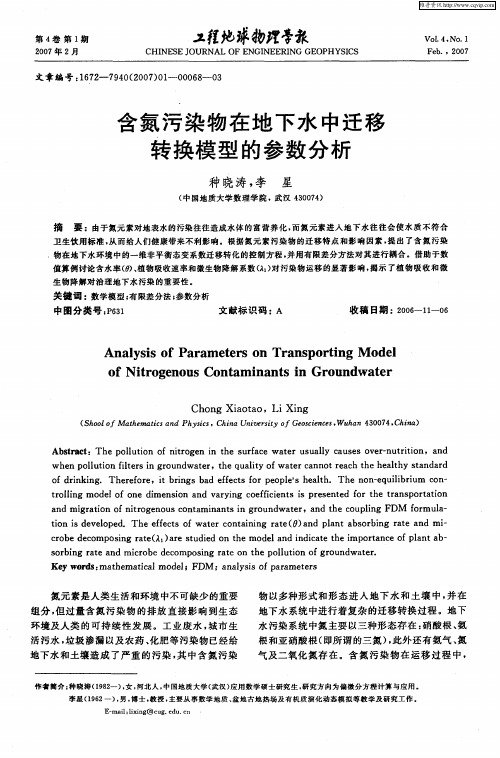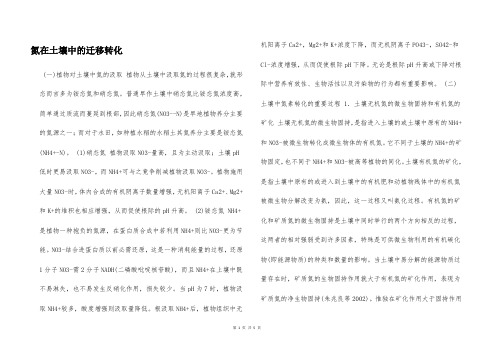氮在地下水中迁移转化规律
同位素示踪方法在地下水污染溯源中的应用研究

同位素示踪方法在地下水污染溯源中的应用研究地下水作为重要的水资源之一,被广泛应用于供水和灌溉等领域。
然而,由于人类活动和自然原因,地下水污染问题日益严重,给人们的生态环境和健康带来了严重威胁。
因此,地下水污染溯源研究具有重要的科学和应用价值。
其中,同位素示踪方法作为一种有效的技术手段,被广泛应用于地下水污染溯源的研究中。
同位素示踪法是利用元素同位素的特点来追踪和确定地下水中各种污染物的来源和流动路径。
同位素指的是同一个元素的原子个数相同但质量不同的不同原子,例如氢同位素有氢-1、氢-2、氢-3等等。
不同的同位素的比例在不同的物质来源中也不相同,这就成为追踪物质来源的一种指示。
首先,同位素示踪法可以通过分析地下水中污染物的同位素组成,确认污染物的来源。
不同地质环境中地下水的同位素特征有所差异,各种污染源也具有不同的同位素组成。
通过对地下水样品中的同位素进行测定分析,可以确定污染物来自哪个或哪些污染源。
例如,氮同位素在化肥和污水中的同位素组成有所不同,可以通过测定地下水中氮同位素组成的差异来追踪和识别化肥和污水对地下水的污染。
其次,同位素示踪法可以揭示地下水中污染物的迁移和转化过程。
污染物在地下水中的迁移过程中,会发生一系列的生物、物理和化学反应,导致同位素组成的变化。
通过对地下水样品中不同位置及不同时间的同位素进行测定,可以揭示污染物在地下水中的迁移路径和转化过程。
例如,硝酸盐是地下水中常见的污染物之一,硝酸盐在地下水中的转化过程中,氮同位素的比例会发生变化,通过测定地下水中硝酸盐氮同位素比例的变化,可以推断硝酸盐的转化过程和迁移路径。
此外,同位素示踪法还可以评估地下水的补给来源和补给速率。
地下水的补给来源和补给速率对地下水的质量和数量具有重要影响。
通过测定地下水中同位素的组成和比例,配合水文地质调查资料,可以评估地下水的补给来源和补给速率。
例如,氢氧同位素在降水中的比例与地下水中的比例具有明显的相关性,通过测定地下水中氢氧同位素的组成和比例,可以揭示地下水的补给来源和补给速率。
2 第三章 地下水的无机化学成分

第三章地下水中的无机化学成分地下水是一种复杂的溶液,地下水中含有70多种元素,地下水中的无机化学成分,按其存在形式和数量可分为四组:(1)大量组分一般含量大于100mg/L,主要是常规的离子形式,Cl-、SO2-4、HCO-3、CO3-、Na+、K+、Ca2+、Mg2+等,另外H+、、NH4+、NO2-、NO3-、H3SiO4-Fe3+、Fe2+等也列入大量组分。
大量组分决定水化学类型。
(2)微量组分一般含量小于10mg/L,常见的是Br、I、F、B 、Mo 、Li 、Cu、Pb 、Zn、P、As、Sr、Ba 、Ni 、Co等数十种。
微量组分不决定水化学类型。
(3)放射性组分U 、Th、Ra、Rn等。
(4)气体组分N2、O2、CO2、CH4、H2S、H2等。
第一节地下水中的大量组分一、氯离子(Cl-)1、迁移性能Cl-具有很强的迁移性能,其原因有三个方面:(1)不形成难溶化合物,Cl-离子与水中大量组分的阳离子(K、Na、Ca、Mg)所形成的化合物溶解很大,例如,30o C时,CaCl2=1020mg/L,NaCl=361.5mg/L,MgCl2=553mg/L。
(2)不被胶体所吸附。
(3)不被生物所吸附。
2、分布规律地下水中的Cl-含量从几mg/L至100mg/L以上均有。
地下水中的Cl-含量随地下水矿化度的增高而增高。
在高矿化度水中,占阴离子首位,形成氯化物水。
3、来源主要有三个方面:(1)有机来源:三废水、化肥、农药、动物及人类的排泄物。
(2)无机来源:盐矿、含盐的沉积物、岩浆岩中含Cl矿物、火山喷出物等。
(3)大气降水:二、硫酸根(SO42-)1、迁移性能迁移性能较强,仅次于Cl -。
SO 42-的迁移性能受下列四个因素控制: (1)水中SO 42-易与Ca 2+、Ba 2+、Sr 2+等离子形成难溶盐。
(2)热带潮湿地区土壤中的Fe(OH)2-、Al(OH)22+胶体可以吸附SO 42-。
农村饮用地下水氮污染转化特性及其防治论文

农村饮用地下水氮污染转化特性及其防治【摘要】饮水安全问题是当今全社会普遍关注的话题。
最大的问题在于使用地下水源的农村,地下水的污染以氮污染最为普遍。
通过对原有资料的整理研究,对比找出地下水氮污染转化的最佳途径,探索其防治的方法,旨在为彻底解决饮水安全问题提供帮助。
【关键词】饮用地下水;氮污染;转化;防治0.引言自2007年11月份,国家决定加大重点饮用水水源地污染防治工程的建设,饮用地下水的安全问题便被提上了纲程。
据悉,我国64%城市地下水污染严重,而由于化肥、农药的大量使用严重污染了地下水水质,加上村民大多使用手压井直接抽取浅层的地下水,因此农村往往成为地下水污染的最直接受害者,严重的导致各种癌症的高暴发率。
近些年来,国内外研究发现许多地区地下水中存在着硝态氮污染问题等[1]。
为此,国内外均展开了一系列措施,进行调查研究模拟。
据了解国内研究的地区有:东北海伦地区、河南省偃师市、河南省林州市、山东临沂市等等。
1.氮如何污染地下水在土壤中,都有铵态氮和硝态氮存在,带正电荷的铵被带负电荷的土壤胶体所吸跗,不会向下移动或从土壤中淋失,而带负电荷的硝态氮不被土攘胶体所吸跗,可以随水流自由移动,同时土壤中的微生物通过正常的生理过程产生硝态氮。
所以不管施入的氮是何种形态,硝态氮在土壤中无所不在;除外来的氮源外,土壤本身的有机质分解也释放硝态氮,这些氮对作物亦有效,但同外源氮-样,也会被淋失,使地下水硝酸盐浓度增加,以致污染水源[2]。
2.硝态氮污染地下水途径2.1 通过包气带渗入农田施用的氮肥,除一部分被植物吸收外,剩余部分残留在土壤里。
在降水时,随雨水渗入地下污染地下水。
2.2 地表水侧向渗入生活污水和工业废水排入河道,不仅污染地表水,而且污染了的地表水又成为地下水的污染源。
降雨时农田径流带入地表水体的氮化物占各种活动排入水体氮素的51%,施氮肥地区氮素的流失比不施地区高3~10 倍。
地表水侧向渗入污染的特征是:污染影响仅限于地表水体的附近,呈带状或环状分布;污染程度取决于地表水的污染程度、河道沿岸地质结构、水动力条件以及距岸边的距离。
含氮污染物在地下水中迁移转换模型的参数分析

Ch n a t o,LiXi g o g Xi o a n
( ho fMah m t s n h s s hn nvri fG oc n e , h n 4 0 7 , hn ) S ol te ai dP yi ,C iaU iest o esi c Wu a 3 0 4 C ia o ca c y e s
收稿 日期 : o6 1 6 2o一l一o
Anay i fPa a e e s o a s r i o e l sso r m tr n Tr n po tng M d l
o t o e o s Co t m i nt n பைடு நூலகம்r u d t r fNi r g n u n a na s i o n wa e
值算例 讨论 含水率( 、 物吸收速 率和微生物降解 系数 (-对污染物运移 的显著影 响 , 植 .) : I 揭示 了植物 吸收和微
生 物 降 解对 治 理 地 下 水 污 染 的 重 要 性 。
关键词: 数学模型; 有限差分法; 参数分析
中图 分类号 :61 P 3
文献标 识 码 :A
氮元 素是 人 类生 活和 环境 中不 可缺少 的重要 组分 , 过量 含 氮 污染 物 的排 放 直接 影 响 到 生 态 但
环境 及人 类 的 可 持续 性 发 展 。工 业 废水 , 市 生 城 活 污水 , 垃圾渗 漏 以及农 药 、 化肥 等污染 物 已经给
生态学中的氮循环

生态学中的氮循环氮是地球上最常见的元素之一,它存在于空气中、土壤中、水中和所有有机物中。
在生物系统中,氮是生命所需的重要元素之一,它参与了多种生物代谢过程。
而生态学中的氮循环则是指各种生物、非生物和化学过程将氮的不同形态转换为有机氮和无机氮(氨、硝态氮、亚硝态氮等)的物质循环过程。
氮循环的主要环节:氮固定、氨化、硝化、反硝化和矿化氮固定是氮循环中最重要的过程之一。
氮固定过程将空气中的氮通过生物固定(如豆科植物根圈内的根瘤菌)或非生物固定(如雷电、太阳辐射)的方式,固定成无机氮形式(氨、硝酸盐等)。
氨化则是生态系统中的重要过程之一,是指将营养物转换为氨的过程。
氨化由微生物媒介的蛋白质分解过程产生,并通过根际微生物将其转化为其他有机氮化合物。
硝化则是把氨或有机氮化合物转化为硝酸盐的过程,其中涉及到两种硝化菌:氨氧化细菌(AOB)和亚硝酸氧化细菌(NOB)。
AOB将氨转化为亚硝酸盐,而NOB则将亚硝酸盐转化为硝酸盐。
反硝化则是指由某些细菌进行的还原硝酸盐为氮气或亚氮化物(比如利用反硝化过程减轻一些农牧业产生的氮排放)的过程。
最后是矿化,这是生态系统中最基本的过程之一,它表示将有机物中的不同形式的氮转化为无机氮的过程。
此过程最常见于生物自然死亡、食物链的生物的排泄和泥沙沉淀等。
氮循环的生态意义氮循环是生态系统中重要的生态过程,有关氮素的呈现形式对于地表生物环境的稳定性、动态平衡的维护和生物生长发育、繁殖等都具有重要的影响。
不论是到草原、森林等自然生态系统还是到农田、城市等人为生态系统,氮循环的生态意义都不可忽略。
首先,氮循环是调控生态环境的重要手段。
当氮素形态和量的变化影响地表生物土壤的生物化学过程时,氮循环可以通过不断转化状态、主导形态与量的变化等方式来调节土壤微生物群落的数量、组成与作用,以达到生态稳定的目的。
其次,氮循环是生态系统能量流过程中产生能量的重要途径。
尤其是在地下水循环和地下生态系统中,氮循环对于维持自然生物系统的运转、人工生产以及国土环境生态安全保障具有极为重要的生态意义。
氮在土壤中的迁移转化

氮在土壤中的迁移转化(一)植物对土壤中氮的汲取植物从土壤中汲取氮的过程很复杂,就形态而言多为铵态氮和硝态氮。
普通旱作土壤中硝态氮比铵态氮浓度高,简单通过质流而蔓延到根部,因此硝态氮(NO3--N)是旱地植物养分主要的氮源之一;而对于水田,如种植水稻的水稻土其氮养分主要是铵态氮(NH4+-N)。
(1)硝态氮植物汲取NO3-量高,且为主动汲取;土壤pH 低时更易汲取NO3-,而NH4+可与之竟争削减植物汲取NO3-。
植物施用大量NO3-时,体内合成的有机阴离子数量增强,无机阳离子Ca2+、Mg2+和K+的堆积也相应增强,从而促使根际的pH升高。
(2)铵态氮 NH4+是植物一种抱负的氮源,在蛋白质合成中若利用NH4+则比NO3-更为节能。
NO3-结合进蛋白质以前必需还原,这是一种消耗能量的过程,还原1分子NO3-需2分子NADH(二磷酸吡啶核苷酸),而且NH4+在上壤中既不易淋失,也不易发生反硝化作用,损失较少。
当pH为7时,植物汲取NH4+较多,酸度增强则汲取量降低。
根汲取NH4+后,植物组织中无机阳离子Ca2+,Mg2+和K+浓度下降,而无机阴离子PO43-,SO42-和Cl-浓度增强,从而促使根际pH下降。
无论是根际pH升高或下降对根际中营养有效性、生物活性以及污染物的行为都有重要影响。
(二)土壤中氮素转化的重要过程 1.土壤无机氮的微生物固持和有机氮的矿化土壤无机氮的微生物固持,是指进入土壤的或土壤中原有的NH4+和NO3-被微生物转化成微生物体的有机氮。
它不同于土壤的NH4+的矿物固定,也不同于NH4+和NO3-被高等植物的同化。
土壤有机氮的矿化,是指土壤中原有的或进入到土壤中的有机肥和动植物残体中的有机氮被微生物分解改变为氨,因此,这一过程又叫氨化过程。
有机氮的矿化和矿质氮的微生物固持是土壤中同时举行的两个方向相反的过程,这两者的相对强弱受到许多因素,特殊是可供微生物利用的有机碳化物(即能源物质)的种类和数量的影响。
渗滤液中氨氮在土壤和地下水中迁移转化实验

了防治渗滤液对土壤和地下水的污染 ,我们通过 入一定体积 不同浓度 的 N 1 HC 溶液 ,在 2 5℃恒
实验 ,采 用 建 模 的方 法 ,对 渗 滤液 中 N H 一N在 温箱 中摇振 3 ,离心澄清后 ,取上清液测N 0h
土壤和地下水中迁移转化做了研究 。
1 模拟 实验
的一种高浓度有机废水 ,由于渗滤液的水质水量 力计读 取土 壤吸 力值 ,并 用来指示 湿润峰 的运 变化大 ,含有多种有害污染物质 ,对周边环境尤 动 ,并通过已测定 的土壤水分特征曲线来求 土壤
其是对土壤和地下水的污染很大 ,对人类的生产 的含水量 。试验 过程 中保持上部密封 ,底部模拟 和生活构成 了威胁 。垃圾填埋场的渗滤液对地下 自由排水。
维普资讯
1 4卷第 2期 2 第 0 6年 4月 0・ 2 0
・
环境卫生工程
E vr n na a i t n En i e rn n i me tlS n t i gn ei g o ao
Vo_ 4 l 1 No 2 . Ap l 0 6 i r 2 0
中圈分类号 :X 9 79 文献标 识码 :A 文章编号 :10 0 5—8 0 (0 6 0 2 6 2 0 )2—0 2 0 0 0— 3
Tr n f r a d Tr n f r f n o NH3 a s e n a s o ma o f l 一N r m e c a e o o la d Gr u d t r f o L a h t n S i n o n wa e L o, Y n n i B a g Xi
1 1 实 验装 置 和步骤 . 1 1 1 实验 装 置 . .
浓度 ,得 ̄ N 4动态吸附模式 : ! H+ I J
氮循环的知识点总结

氮循环的知识点总结氮的来源氮是地球大气中含量最丰富的气体之一,占据大气的78%。
氮气并不容易被生物直接利用,只有少数植物和微生物能够将氧化氮还原成氨,然后再转化成有机氮化合物,以供生物利用。
除了大气中的氮气,氮也存在于土壤中、水体中和生物体内。
一般而言,氮的来源主要有以下几种途径:1. 大气中的氮气:氮气通过闪电活动和化石燃料燃烧等方式进入大气,形成氮氧化物和硝酸盐等氮化合物,随着降水和大气沉降进入土壤和水体中。
2. 土壤中的氮:土壤中的氮主要来源于植物残体的分解、微生物的转化以及大气的沉降。
土壤中氮的主要形式有有机氮和无机氮。
3. 水体中的氮:水体中的氮来源于大气的沉降、植物和动物的排泄物、腐殖质的分解以及人类活动等。
4. 生物体内的氮:生物体内的氮主要来自于食物链的转移和新陈代谢产生的废物。
氮的固定氮的固定是指将大气中的氮气转化为植物可利用的形式。
氮的固定主要是由一些植物和微生物完成的,主要包括以下几种方式:1. 大气固定:少数植物的根系中寄生着一种叫做根瘤菌的微生物,它们能够从大气中固定氮气,将其转化为植物能够利用的氨。
2. 人工固定:人类通过合成氨法等工业生产方式,固定了大量的氮气,用以生产化肥和其他化学品。
氮的转化氮的转化是指在生物体和非生物体的作用下,将氮从一种化合物转化为另一种化合物的过程。
氮的转化主要包括以下几种方式:1. 氮的硝化:氨和有机氮通过细菌的作用,转化为亚硝酸盐和硝酸盐。
2. 氮的还原:亚硝酸盐和硝酸盐通过一系列的还原反应,转化为氮气或氨。
3. 氮的铵化:硝酸盐和亚硝酸盐转化为氨。
4. 氮的硝化:氨和有机氮通过细菌的作用,转化为亚硝酸盐和硝酸盐。
氮的循环氮的循环是指氮在地球上不同环境中的循环过程。
氮的循环主要包括以下几种方式:1. 植物吸收:植物通过根系吸收土壤中的氮元素,将其转化为有机氮化合物,供自身生长和繁殖所需。
2. 动物摄取:动物通过食物链摄取植物中的氮元素,将其转化为自身所需的蛋白质和其他有机物质。
氮循环_精品文档

氮循环氮循环是自然界中重要的生物化学循环之一,主要涉及氮在大气、土壤、水体和生物体之间的转化过程。
氮是构成生物体的基本成分之一,对维持生物体的生长和繁殖起着重要的作用。
尽管氮在地球上的存在量是相对丰富的,但氮的利用和转化并不容易,因为大气中的氮气(N2)对大多数生物体是不可利用的。
氮的循环过程可以分为氮固定、氮硝化、氮还原和氮脱氧四个主要环节。
首先是氮固定的过程。
氮固定是指将大气中的氮气转化为可供生物利用的形式,主要由两种方式完成:生物固氮和非生物固氮。
生物固氮主要是通过一些特殊的细菌和蓝藻完成的,它们能够将大气中的氮气固定为氨(NH3)或硝酸盐(NO3-)等形式。
非生物固氮是指氮的人为固定过程,主要包括工业固氮和农业固氮。
工业固氮是指通过工业化的过程将氮气转化为氨或尿素等化合物,用于农业生产或其他用途。
农业固氮是指通过农业实践,如植物和微生物的共生关系,将氮气转化为可供植物吸收的形式。
接下来是氮硝化的过程。
氮硝化是指将氨或亚硝酸盐(NO2-)转化为硝酸盐的过程。
这个过程主要由一些氧化细菌完成,最终产生的硝酸盐可供植物吸收。
氮硝化是一个氧化过程,需要氧气作为电子受体,而产生的亚硝酸盐则是进一步氧化的中间产物。
然后是氮还原的过程。
氮还原是指将硝酸盐还原为亚硝酸盐、氨或一氧化氮(NO)等形式的过程。
这个过程主要由一些还原细菌完成,还原细菌可以利用硝酸盐作为电子受体来进行能量代谢。
在有缺氧的环境下,氮还原是一个重要的能量供应途径,同时还可以产生一些氮气。
最后是氮脱氧的过程。
氮脱氧是指将氨、亚硝酸盐或硝酸盐等形式的氮还原为氮气的过程。
这个过程主要由一些脱氧细菌完成,这些细菌能够利用还原形式的氮来进行能量代谢,并产生氮气作为代谢产物。
氮脱氧是一个重要的过程,可以防止氮积累过多从而对环境造成污染。
总之,氮循环是一个复杂而重要的生物化学循环,通过氮固定、氮硝化、氮还原和氮脱氧等过程,实现了氮在大气、土壤、水体和生物体之间的循环转化。
自然界中的氮循环

自然界中的氮循环
氮循环是指在自然界中氮元素通过各种反应形式传递的过程,是其中一项重要的营养元素的循环。
氮循环分为大气循环、植物循环和土壤循环三个部分。
大气循环是氮的最终归宿,一是大气中的氮原子,当其暴露在强紫外线的照射下,会被氧活化而成可溶性的尿素,分解而形成氮气。
氮气在雨水和其他水体的作用下,会被还原,形成氨等有机氮化合物,这些化合物可以被动植物和细菌合成利用。
植物循环是植物从氨等有机氮化合物中取得氮元素,进行光合作用,利用太阳能将CO2与H2O分解成氨、糖、烯醇等有机物,植物利用这些物质生长发育,而在此过程中释放的CO2又回到大气。
植物死后,经土壤微生物分解释放出的氮元素,又流入到地下水中,经天然回归再返回大气,形成了一个完整的氮循环。
土壤循环是有机物和无机物完成氮元素流动的过程,这种循环可以通过土壤中的微生物和植物把氮从原有化合物形式释放出来,使氮得以流通利用。
细菌利用土壤中的尿素、氨等有机氮化合物,可以把它们氧化成氮气,并作为植物吸收使用的氮源,也可以还原成氨等有机物再次流入植物的体内,这样就形成了氮循环的一个重要环节。
土壤水-氮-盐运移规律及其再分布特征

土壤水-氮-盐运移规律及其再分布特征
土壤水-氮-盐的运移规律及其再分布特征主要受到以下几个因
素的影响:
1. 土壤性质:不同类型的土壤具有不同的物理、化学特性,其中包括孔隙度、比表面积、质地、容重等。
这些土壤性质直接影响着土壤中水分、氮和盐的运移速度和途径。
2. 水分运移:土壤水分的运移主要通过土壤孔隙中的水流和蒸发过程进行。
水分的运移方式包括重力流动、毛细作用和蒸发散失等。
因此,土壤水分的再分布也会影响氮和盐的运移和再分布。
3. 氮的运移:氮的运移主要通过土壤中的水流和根系吸收进行。
氮的运移方式有扩散、质量流动、毛细运动等。
氮在土壤中的移动速度和可利用性受到土壤pH值、氮素形态、含量和土壤
水分等因素的影响。
4. 盐的运移:盐的运移主要通过离子扩散、溶液流动和质量流动等过程进行。
土壤中的盐分主要来自化肥、灌溉水或地下水中的溶解盐。
盐分的运移速度和途径受到土壤孔隙结构、水分和温度的影响。
根据上述因素的影响,土壤水-氮-盐的运移和再分布特征可总
结如下:
1. 土壤水分的再分布会导致氮和盐的移动和再分布变化。
2. 盐分在土壤中相对容易迁移,特别是在土壤中水分较大的情况下,容易随水分一起向下迁移。
3. 氮的运移速度相对较慢,容易被土壤固定或吸附而减少运移。
4. 土壤孔隙度和质地对氮和盐的运移有重要影响,细质土壤中水分和溶质的运移速度较慢。
综上所述,土壤水-氮-盐的运移规律及其再分布特征受到土壤性质、水分运移、氮的运移和盐的运移等因素的综合影响,它们之间存在着复杂的相互关系。
农田土壤的氮循环

农田土壤的氮循环农田土壤的氮循环农田土壤中的氮元素是植物生长的重要营养源之一,而氮的循环过程对农作物的生长发育具有重要的影响。
本文将探讨农田土壤中氮的来源、转化和损失的过程,以及如何合理管理土壤氮,提高农作物产量和质量。
一、土壤中氮的来源氮的主要来源可以分为气氛氮和土壤有机氮两部分。
1. 气氛氮空气中的氮气(N2)是气氛氮的主要组成部分,但大多数农作物无法直接利用氮气。
氮气通过闪电放电、工业氮固定和土壤微生物的作用转化为植物可以利用的形态。
2. 土壤有机氮土壤有机氮主要来自植物残留物、动物排泄物和微生物尸体等有机质的分解过程。
这些有机物在土壤中腐解后,会释放出氨气(NH3)和无机氮(如尿素和硝酸盐)等形式。
二、土壤中氮的转化过程土壤中的氮经历了一系列的转化过程,包括氨化、硝化和固氮等。
1. 氨化作用氨化是指氨气(NH3)或尿素(CO(NH2)2)在土壤中转化为铵离子(NH4+)的过程。
这一过程主要由土壤中的氨化细菌完成。
2. 硝化作用硝化是指铵离子(NH4+)转化为硝酸盐(NO3-)的过程。
硝化分为两个步骤:一氨氧化和硝化。
- 一氨氧化是由一氨氧化细菌完成的,将铵离子氧化为亚硝酸盐(NO2-)。
- 硝化是由硝化细菌完成的,将亚硝酸盐进一步氧化为硝酸盐。
硝化过程是氮循环中最关键的环节之一,硝酸盐是农作物主要吸收的形态,也是氮损失的主要路径之一。
3. 固氮作用固氮是指将空气中的氮气转化为化合态氮的过程,主要由固氮菌完成。
这些菌类能够将氮气固定为氨气或有机氮,进而进入土壤中。
三、土壤中氮的损失在农田土壤中,氮的损失主要包括氨氧化后的亚硝酸盐流失、硝酸盐淋失、挥发损失和微生物作用等。
1. 亚硝酸盐流失亚硝酸盐在土壤中比硝酸盐不稳定,容易通过土壤渗漏到地下水中,导致氮的流失。
2. 硝酸盐淋失硝酸盐在土壤中溶解度较高,容易随着水分的流动迁移到下层土壤或地下水中,造成氮的淋失。
3. 氨气挥发损失土壤中的氨气在碱性条件下容易挥发为氨气,导致氮的损失。
氮污染在地下水中迁移、转化规律的研究

除 率 。同 时得 出 , 无论 哪 种 地 下 土质 对 氨 和 硝 酸 盐 的 阻截 能 力都 较 弱 , 突 发 污 染 恢 复 力 也 同样较 弱 。 对 关 键 词 污 染 河 流 氮 污 染 地下水 渗 透 研 究
,
a sr t Nt gn ad i m o n s aeb cm e a r l t t o r c a r dg u d a r I t s a e ,ui f b t c io e n s o p u d v eo e h j l a s f uf e t r n w t . i pp r s g i a r tc h t m op u n s a w ea o n o e nh n d-
随着工 业 的发 展 和 人 口的 增 加 , 流 污 染 日 河
的含水 率 、 隙 率 和渗 透 系数 。所 取 土样 的 位 置 孔
为沈 阳浑南地 区地 铁 3号 线 浑河 站 与距 离 浑 河 大
桥 约 lm的浑河 北 岸边 。地铁 3号 线 浑河 站 取 土 k 深 度 为除表层 植 被外地 下 2 0m、3 c 20 m 和 0 c 2 0 m、6 c
氮污 染在地 下水 中迁 移 、 化规 律 的研 究 转
李 晶
氮污染在地下水中迁移、 转化规律的研究
S u y o a se fNi o e olt n i o n wa e t d n Tr n f ro t g n P l i n Gr u d t r r uo
稀土矿区地下水“三氮”分布特征及迁移转化规律

• 180 •有色金属(冶炼部分)(http://ysyl. bgrimm. cn)2021年第3期doi: 10. 3969/j. issn. 1007-7545. 2021. 03. 027稀土矿区地下水“三氮”分布特征及迁移转化规律伏慧平1,陈仁祥2,宋勇2,王太伟2,高柏“3(1•东华理工大学水资源与环境工程学院,南昌330013;2.江西省核工业地质局二六四大队,江西赣州341000;3•东华理工大学核资源与环境国家重点实验室,南昌330013)摘要:“三氮”浓度是稀土矿区地下水质量评价的重要指标,“三氮”污染特征的分析以及迁移转化规律的揭示对水环境监测和污染治理具有重要意义。
以龙南离子型稀土矿区地下水为研究对象,通过钻孔取样和水质分析,探讨地下水中“三氮”的分布特征以及迁移转化规律。
结果表明:1)龙南稀土矿区地下水中,“三氮”在松散岩孔隙水中的浓度略大于风化带裂隙水,N H3-N浓度远超地下水IE类水标准,最大超标倍数48. 42倍,超标率31. 71%,N03-N、N02-N浓度较低,无明显超标现象。
2)N H3-N以浸矿区为中心,沿地下水径流方向迁移,水平迁移距离约3 500 m;“三氮”在松散岩类孔隙水中的迁移速度大于在风化带网状裂隙水,土体渗透系数越大,“三氮”迁移速度越快。
3)“三氮”在地下水中的转化机制主要是硝化反应、反硝化反应以及N H.t +的挥发作用和N O f的自分解反应,p H是影响矿区地下水中“三氮”富集以及相互转化的重要因素。
关键词:离子型稀土矿;地下水污染;“三氮”;分布特征;迁移规律中图分类号:X523文献标志码:A文章编号:1007-7545(2021)03-0180-07Distribution Characteristics and Migration and Transformation Rule of “Three Nitrogen” of Groundwater in Rare Earth Mining AreaFU Hui-ping1,CHEN Ren-xiang2,SONG Yong2,WANG Tai-wei2,GAO Bai1,3(1. School o f W a te r R esources and E n v iro n m e n ta l E n g in e e rin g. East C hina U n iv e rs ity o f T e c h n o lo g y,N anchang 330013, C h in a;2. N o. 264 B rigade o f th e J ia n g xi N ucle ar In d u s try G eological B u re a u, G anzhou 341000, J ia n g x i, C h in a;3. S tate K e y L a b o ra to ry o f N u cle a r Resources and E n v iro n m e n t, E ast C hina U n iv e rs ity o f T e c h n o lo g y,N anchang 330013, C hin a)Abstract:Concentration of“three nitrogen”is an important index for groundwater quality evaluation in rare earth mining areas.Analysis of pollution characteristics of“three nitrogen”and revelation of migration and transformation rule are great significance for water environment monitoring and pollution control.Distribution characteristics of three nitrogen ’’in groundwater and its migration and transformation rule were discussed through borehole sampling and water quality analysis in Longnan ion-type rare earth mining area.The results show th at:1) rare earth mining area groundwater in Longnan,“three nitrogen”in concentration of unconsolidated rock pore water is slightly greater than that of zone of weathering fissure water,concentration of NH3-N far exceeds the groundwater class H I water standard,收稿日期:2020-10-22基金项目:国家自然科学基金资助项目(41362011);江西省重点研发计划项目(2018A C G70023)作者简介:伏慧平(1996-),男,云南曲靖人,硕士研究生;通信作者:高柏(1964-),男,江西九江人,博士,教授2021年第3期有色金属(冶炼部分)(h ttp://ysyl. bgrimm. ell)• 181 •the largest excess multiple is 48. 42 times with over standard rate of 31. 71 %,and N()3-N and N()2-N concentration is low and has no obvious exceed standard. 2) NH3-N migrates along the direction of groundwater runoff with leaching mining area as the center,and the horizontal migration distance is about 3 500 m.Migration rate of“three nitrogen”in pore water of loose rock is higher than that in fissure water of network of weathering zone.The big the permeability of soil is,the fast the migration rate is. 3) Transformation mechanism of“three nitrogen”in groundwater mainly includes nitrification reaction, denitrification reaction,volatilization of NH, 'and self-decomposition reaction of NO^.An important factor affecting enrichment and mutual transformation of“three nitrogen”in groundwater in mining areas is pH value.Key words:ionic rare earth ore;groundwater pollution;“three nitrogen”;distribution characteristic's; migration patterns近年来土壤和地下水污染事件时有发生,其中 工业生产造成的水土污染较为严重,场地土壤和地 下水的污染范围、污染程度、持续时间以及环境风险 和健康风险等是社会公众和学术界关注的焦点[13:。
浅论地下水中的氮污染

[ 要] 近几十年随着工农业生产的发展, 摘 农村、 城市的地下都存在着不同程度的氮污染问
题 , 下水逐 渐成 为 氮元 素的 “ 地 储存库 ” 。而含 水层 对 氮的 自净 能力极 为有 限,且 氮对地 下水 的污染具
有后遗 效应[ ,使 得 氮污染 对地下水 水环 境 的危 害重 大。论 述地 下水 中氮的来 源 ,氮 污染的危 害 、途 1 ] 径 ,影 响其迁 移 的因素及其循 环转化机 理 ,并提 出防 治对策 。
ee n .Bu h t r b a i g s r t m a r a i t to o ir g n p rf a in, h i o e l me t tt ewa e - e rn ta u h sa g e tl mi i n f rn t o e u i c t a i o t en t g n r l s s e f c o g o n wa e o l t n,S h i o e o l to r a a m f l o g o n wa e n i o e fe tt r u d t r p lu i o O t e n t g n p l i n i g e th r u r u d t re v — r u s t r n e t Th s a t l d s u s ss u c s o i o e o m n. i r i e ic s e o r e fn t g n,h r ,a p o c n n l e c fn t o e o l — c r am p r a h a d i fu n e o ir g n p i u t n,is mo e n a t r n h c a i m fc r l r n f r t n i o t v me tf c o s a d t e me h n s o i e ta so ma i ,p t o wa d s m e c u t r c o u sf r r o o n e —
氮污染物在非饱和土壤中迁移过程对地下水水质影响分析

第 8卷
第 4期
南 水 北 调 与 水 利 科 技
S uht- rhWae asesadWae c ne& T cn lg o t—oNot trTrn fr n trSi c e eh oo y
Vo. No4 1 8 .
Au 晷 2 1 00
2 1 年 8月 00
d i1 .7 4 S . .2 12 1 .45 o:0 32 / P J 10 .00 0 O 8
低温孔隙地热水中铵氮的迁移转化规律

低温孔隙地热水中铵氮的迁移转化规律
温孔隙地热水是指采用深度地下水,利用地温对水进行加热或冷却,以解决室内冬季采暖或夏季制冷的技术。
温孔隙地热水中铵氮的迁移转化规律主要有以下几个方面:
一、温度对铵氮的影响
1、温度升高会增加铵氮的溶解度和可迁移性,但超过25℃以后铵氮溶解度和可迁移性的增加量会变小。
2、当温度高于一定值时,铵氮会分解形成氨气,而反过程则会随着温度的降低。
二、pH值对铵氮的影响
1、pH值升高会直接影响铵氮的溶解度和可迁移性,pH值小于6时,铵氮不易溶解、可迁移性较差;而pH值大于8时,铵氮溶解度和可迁移性会有一定的提高,但是到达9时又会下降。
2、此外,碳酸和碳酸盐等腐殖物中的负载离子也会影响pH值从而影响铵氮的迁移转化。
三、地理环境因素对铵氮的影响
1、地理位置也会大大影响温孔隙地热水中铵氮的迁移转化,比如群山、沙漠等比较少水源的地方,铵氮的迁移转化情况比较差。
2、温度也会对铵氮的迁移转化产生重要影响;当气温高于设定温度时,铵氮会相对较快的离开地表;反之,当气温低于设定温度的时候,铵
氮的溶解度和迁移性会减少。
四、水体交换特性
1、地表水体受污染或缺水时,深层地表水体和空气对铵氮的吸附和迁
移会有很大作用。
2、深层地下水和地表水体之间会发生持续的运动,地表水体中的碱度、溶解固体以及硫酸盐等污染物会影响铵氮的迁移转化。
通过以上分析,我们可以得出结论:温孔隙地热水中铵氮的迁移转化
受多种因素的影响,其中温度、pH值和地理环境等因素的影响最为明显,而水体交换特性也是影响铵氮迁移转化的重要因素。
地下水污染机理

二、有机污染物的理化性质
• 有机化合物自身的结构、疏水性、挥发性和稳定性等都是影响其在土 壤中迁移转化的内在因素。 有机污染物的浓度也是一个重要因素。
顺式二氯乙烯
浓 度
三、土壤特性
• 土壤的很多性质,如有机质含量、矿物组成、离子交换容量、比表面积、粒 径分布、极性指数、固体效应等,对有机污染物吸附产生影响。Chung和 Alexander用16种性质迥异的土壤进行污染物吸附实验,发现菲或阿特拉津 在各种土壤中吸附的速率和程度明显不同,有机碳含量、阳离子交换容量和 土壤的其他性质可能有助于预测一些化合物的吸附。
一、影响污染物迁移的水文地球化学效应
一、物理作用效应
物理作用效应主要包括机械过滤及稀释作用,他们主要产生净化效应。
1.机械过滤。机械过滤作用取决于介质的性质及污染物颗粒的大小。过滤效果主要是去除悬浮物, 其次是细菌。 2.稀释作用。当污水与地下水混合时,便会产生稀释作用。稀释作用主要是使污染物浓度变低。
地下水污染物的迁移转化 及污染机理
地下水污染物的迁移及污染机理
1 污染物在地质环境中的水文地球化学效应 2 主要污染物的相对迁移能力及其主要衰减机理 3 地下水系统的污染及污染机理
1、污染物在地质环境中的水文地球化学效应
污染物在通过包气带向下运移时,会产生一系列复杂的物 理、化学及生物作用。 其中,对污染物的迁移存在两种水文地球化学效应:阻止 迁移效应(或称净化效应)和增强迁移效应。
化学吸附:靠化学键结合,被吸附离子进入胶体的结晶骨架。主要对 Al、K、Mn、Zn、Cr、Ni等金属离子起作用,对有机化合物,如对硫磷、 毒莠定,西维因、百草枯、多氯联苯等也能吸附。是不可逆的。
污染物在地下水系统中的迁移转化

溶液中的[Ba2+]突然增大,于是[Ba2+][SO42-]>Ksp,原
来的平衡遭到破坏,平衡向左移动,结果析出更多的
BaSO4沉淀。当溶液中再次达到平衡时,沉淀停止析出。 这时,[Ba2+]大于BaSO4溶解在纯水中的Ba2+离子浓度, 而[SO42-]则小于BaSO4溶解在纯水中的SO42-离子浓度。 BaSO4的溶解度可用达到平衡时的[SO42-]来量度,因此, BaSO4在BaCl2溶液中的溶解度比在纯水中要小。这种因 加入有共同离子的强电解质而使BaSO4溶解度降低的效 应,叫做同离子效应。
3、溶解—沉淀平衡的移动
1)盐效应
例题6—l 在石膏(CaSO4·2H2O)的饱和溶液中,加 入0.1mol KNO3。计算在加入KNO3前后石膏的溶解度 变化。已知CaSO4·2H2O的Ksp=1.0×l0-3.58。
解:
CaSO4·2H2O
Ca2++SO42-+2H2O
解法一:不考虑离子活度系数,设离子浓度即为活
K
1 39.10 1.33 5.32
NH4 1 18.01 1.43 5.37 Rb 1 85.48 1.49 5.09
H
1 1.008
Ca 2 40.08 1.06 10.00
Mg 2 24.32 0.78 13.00
代换力顺序
第七 第五 第六 第四 第一 第二 第三
土壤中一些阳离子代换力的大小排列顺序如下: Fe3+≥A13+>H+>Ba2+>Sr2+>Ca2+>Mg2+>Cs+>Rb+ >NH4+>K+>Na+>Li+
- 1、下载文档前请自行甄别文档内容的完整性,平台不提供额外的编辑、内容补充、找答案等附加服务。
- 2、"仅部分预览"的文档,不可在线预览部分如存在完整性等问题,可反馈申请退款(可完整预览的文档不适用该条件!)。
- 3、如文档侵犯您的权益,请联系客服反馈,我们会尽快为您处理(人工客服工作时间:9:00-18:30)。
氮在地下水系统中的迁移转化挤数学模型摘要:近年来,我国部分地区地下水硝酸盐污染态势十分严峻,特别是集约化种植区由于施用大量氮肥导致的硝酸盐污染更为严重。
为控制污染,应掌握地下水硝酸盐污染的空间变异规律与分布特征。
采用地统计学方法.结果表明,不同区域地下水硝态氮含量存在一定的差异,存在明显的趋势效应以及变异性,且含量随地下水深度增加而减少。
通过相关性分析,获得与地下水硝态氮含量相关性最高的两个因子(土壤有机质含量和全氮含量),并作为协克里金(Cokriging)插值方法中的协同因子,地下水硝酸盐污染进行插值。
经比较分析,协克里金法比普通克里金法(OrdinaryKriging)的精度高,减少了80%的平均误差。
协克里金法空间插值结果表明,空间分布规律表现在从西南到东北逐渐升高的方向性效应,而地下水硝态氮含量较高的区域主要分布在潍坊、青岛、烟台种植区,如青岛的平度、莱西,潍坊的寿光等农业较发达的种植区。
关键词:地下水硝酸盐污染;空间变异;地统计;协克里金法Abstract:In recent years, groundwater nitrate pollution in some regions of China is very serious. Especially,nitrate pollution in intensive cultivationareas is more serious for the application of a large number of nitrogen fertilizer. The objective of this preliminary research is to investigatethe potential of application geo statistical method to explore spatial variability of groundwater nitrate pollution in Shandong intensivefarming regions in China. Detailed sample data of groundwater nitrate nitrogen were collected in 175 farming sites representing the typicalcropping systems in the study area. Semi-variole of the geo-statistical method was used to analyze the groundwater nitrate nitrogen spatialvariability based on the 175 sample sites data. The results indicated that there was an obvious variability and trend effect that gradually increasingfrom the southwest to the northeast. Furthermore, the concentration decreased with the increase in the depth of groundwater. For obtainingthe spatial variation of groundwater nitrate nitrogen in the whole study area, cokriging method was utilized to interpolate the groundwaternitrate nitrogen pollution with two synergy factors(e.g. soil organic matter content and total nitrogen content)which were the most obviousrelevant with groundwater nitrate nitrogen concentration. Compared with ordinary cringing method, cokriging method achieved higher precisionwith a decrease of 80% of the average error. Cokriging spatial interpolation results showed that areas with higher nitrate nitrogen concentration in groundwater mainly distributed in Weifang, Qingdao, and Yantai intensive farming regions, due to the excessive use of nitrogenfertilizer in these regions. The result suggested that the cokriging spatial interpolation was an effective approach of obtaining the groundwater nitrate nitrogen spatial variability in intensive farming regions. The possible reasons for thespatial variation and distribution characteristics of groundwater nitrate nitrogen were discussed.Keywords:groundwater nitrate pollution; spatial variability; geo statistics; cokriging世界上可供人们使用的淡水只有4.9%,而其中有68%是地下水。
地下水是许多人的重要水源,甚至是惟一的饮用水源。
随着地表水污染的加重而不适合作为饮用水源,人们对地下水的依存程度将不断上升。
然而,无论是在工业发达国家还是发展中国家,由于农村地区大量氮素化肥的施用,生活污水和含氮工业废水的未达标排放及其渗漏,固体废弃物的淋滤下渗,污水的不合理回灌,以及地下水的超量开采等,导致地下水中硝酸盐氮浓度呈上升趋势,成为一个重要的环境问题。
1 地下水硝酸盐污染的过程及危害1.1 硝酸盐污染的来源水污染主要是由于人类的工农业生产和其他社会活动所造成的,地下水中硝酸盐的污染也是如此。
农业施肥、生活污水和含氮工业废水的渗漏、固体废弃物的淋滤下渗、污水的回灌、大气沉降等都会引起地下水中硝酸盐浓度的上升[3]。
1.2 农业施肥造成的污染自20世纪初实现氮素化肥的人工合成以来,全球农作物单位面积产量的大幅度提高在很大程度上依赖于氮素化肥施用量的不断增加。
2002年,我国化肥的施用量达433.9亿kg,其中氮肥215.7亿kg,约占50%。
已有研究表明,过量施用的氮肥仅有30%~40%被农作物吸收利用,大部分氮肥经各种途径进入环境中,尤其是径流和淋溶损失造成许多地表水和地下水中的硝酸盐含量过高[4]。
有研究表明,地下水中的硝酸盐氮引起的污染与氮肥施用量成线性关系[5]。
1.3 生活污水和工业废水的污染任意排放的生活污水及未达标处理的一些工业废水直接排入江、河、湖、海等自然水体,污染地表水,受污染的地表水又经渗透作用进入地下水中污染地下水。
由于此类污水中含有大量的氨氮和有机氮化物,在微生物等的作用下,很容易转化成硝酸盐积累在土壤中,进而污染地下水。
据统计,1999年我国工业和城市生活污水排放总量为401亿t,其中工业废水排量为197亿t,占总排放量的49.1%。
工业废水和生活污水的排放导致全国78%的河湖水体和85%的城市附近水域遭受不同程度的污染,河水的污染进而影响了沿岸地区地下水水质[6]。
1.4 固体废弃物的渗滤下渗污染我国人口众多,居民的生活垃圾数量也很大。
固废和生活垃圾占用大片土地,通过降雨的淋滤渗漏会使污染物随雨水渗入地下含水层,对地下水造成污染。
城市生活垃圾含氮量很高,通过对某水源井区垃圾堆放场附近水源井的监测表明,垃圾渗滤液对地下水有明显的污染,井群周围地下水中硝酸盐含量平均每年以2.6mg/L的速度升高[7]。
另外,由于畜牧业、养殖业的迅速发展,造成其周围的畜禽粪便大量堆积,引起区域性地下水水质污染越来越严重。
如美国农场每年由于畜禽粪便的堆积而进入环境中的氮约有650万t。
些粪便垃圾中所含的氮经淋溶下渗作用进入土壤后,再进一步进入地下水中并被转化为硝酸盐。
所以农场或养殖场周围的地下水中硝酸盐均明显超标,是潜在危险较大的污染源[8]。
1.5 污水回灌引起污染为了缓解水资源短缺及缺水地区或干旱缺水季节灌溉水源不足的问题,污水灌溉得到了广泛应用。
据统计,我国污水灌溉农田面积从1963年的4.2万hm2发展到1998年的361.8万hm2,后者占全国总灌溉农田面积的7.3%[9]。
由于我国污水处理水平较低,污灌水严重超标,污染农田、对土壤和农作物形成危害,而且造成对地下水的污染。
污水灌溉是我国农村水环境恶化的主要原因之一,如北京一个污水灌溉区连续灌溉3年后,地下水中NH4+-N平均每年升高1.04mg/L[10]。
1.6 大气沉降汽车、火车、飞机、锅炉等燃烧石油类燃料、煤炭、天然气,会产生大量的氮氧化物。
大气中的氮氧化物通过干湿沉降到地面,溶于各类地表水,再进入地下水,造成地下水的污染。
有资料表明,美国每年通过大气沉降进入地下水的氮约有320万t[11]。
2地下水硝酸盐转化过程与机理一般认为,有机及无机氮转化为硝酸盐主要经历如下过程(如图1所示): 固化过程,大气中79%是氮气,而大多数生物不能直接利用氮气,通过闪电、生物固氮等自然固氮过程,可将大气中的氮气转化成一氧化氮或被固氮菌固定为无机氮化合物,就可以被植物利用[1]; 矿化-吸收过程,有机氮在微生物作用下被转化为NH4+-N并被植物吸收; 硝化过程,微生物将NH4+-N氧化成NO2--N,进而氧化成NO3--N; 反硝化过程,化合的氮以气态的氮(N2、N2O、NO、NO2)返回大气层中。
氮在饱和土壤层中迁移转化特征的研究表明:氮主要以硝酸根的形式污染地下水,其循环迁移与地下水运动密不可分[2]。
2.1地下水采样与硝态氮测定方法山东农科院于2006年11月利用遥感和地理信息系统技术,侧重于集约化种植区,进行研究区地下水硝酸盐污染抽样。
